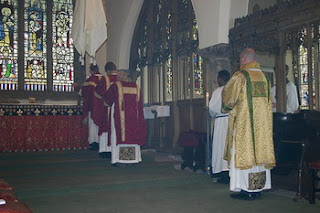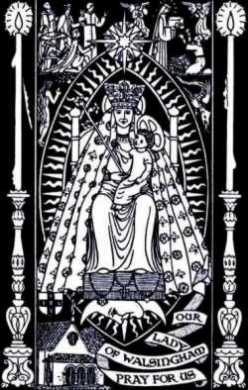Tridentine High Mass.
English Missal High Mass, the use of York.

The view from the altar at the Oratory, Mirfield.
As many of you are aware, the Pope released a document recently, called a Motu Proprio, generally meaning 'off his own back', which addressed the subject of the Tridentine, or Old Rite Mass. Generally thought to have been abolished after the Second Vatican Council, the Old Rite used language and ceremony which had been modified and embellished over the years to something akin to the top photograph. The problem was that falling numbers and the social revolution of the 1960's made the Vatican think that it must change with the times, and present itself as integral to life, rather than separated from reality. (I have always argued that we need to continually make the message of salvation relevant, but we also need to keep the sacred Mass sacred and full of grace and truth). The Novus Ordo was introduced, the Mass changed, churches were re-ordered and, well, you know the rest, some awful things were done and some awe-full things were done. Mgr LeFebvre was excommunicated for consecrating 4 Bishops for his schismatic Society of St Pius X (one of whom, the charming Mgr Bernard Fellay, I have had the great pleasure of meeting) and everyone said that no good would come of it. We Anglicans, under the guidance of Dom Gregory Dix OSB, had already done some minor reordering in the 50's and that coupled with a shortage of funds, meant that we escaped much of the destruction of sanctuaries that affected the Roman Church.
Fast forward a few decades, and the SSPX has gained strength, the traditional Mass is beginning, through such societies as Una Voce, to be said and wanted again and we are rediscovering a sense of the sacred that is not dictated by out-dated fashions which mean nothing to many younger Catholic minded Christians.
So the Pope has taken a very brave step. Brave because he was one of the main players in Vatican II, brave because most of the world's Bishops are men who have joined the Churches and felt the call of God through the Changes of the Council and are unlikely to want to relinquish their party viewpoint and brave, moreover, because he is acting in accordance with the signs of the times. In an increasingly secular would, there is a drastic need to rediscover a sense of the numinous, an echo of the power of the wind which blew over the waters at the beginning of time. I am not suggesting that we adopt the Tridentine Latin Mass in the Anglican Church, that would be outside of our tradition and something of a misnomer, nor am I advocating compulsory lace albs (I am always scared of ripping them, so will not use them), nor am I raising a cry to push our altars back against the walls. What I am suggesting is that HOC EST ENIM CORPUS MEAM, this IS my body, is a real and true statement, as we Catholics in the CofE believe, and therefore what we have is the life of the world as the centre of our lives, so we need to find a way to celebrate that.
The Motu Proprio is, in essence, about tolerance and sharing the central truth of the resurrection with as many people as possible, in a way which brings them close to the Wellspring of Truth. It is about following the Morning Star to the ends of the world. There is a time to respect the new and a time to bring all the old things out again, because words, actions and objects which have been used to worship God become themselves hallowed with the memory of those who used them. This is a time to rediscover our past, to face the future bravely and square in the face and say 'we are the Church of God, the Risen Lamb who was slain and who came back from the dead is our flag, and our Eucharistic Reality urges us ever on'. Face East, face West, wear fiddlebacks, wear Gothic, but be the best you can be and keep your eyes fixed on the Ascended Saviour.
The Roman Church will suffer arguments aplenty over this document. We in the Anglican Church have spent years bickering over fashions in the Sanctuary and in the street. I have heard enough people talking about Birettas and whither the maniple to send me to sleep. The Mass is the Mass is the Mass, whether Book of Common Prayer, Common Worship, Novus Ordo, English Missal, the focus is Christ. We know this, because we have seen,like Thomas. Let us show our unity in diversity of expressions of Faith, but let the Christ be evident in our actions and in our worship and in our lives.
And stop bickering about stylistics! The Roman Church has set us a rare example of tolerance and understanding of Liturgical differences, let us try to follow that example in Spirit, and pray, as always, that all God's people may be one.




_Black_s_s_s_s_s.jpg)
